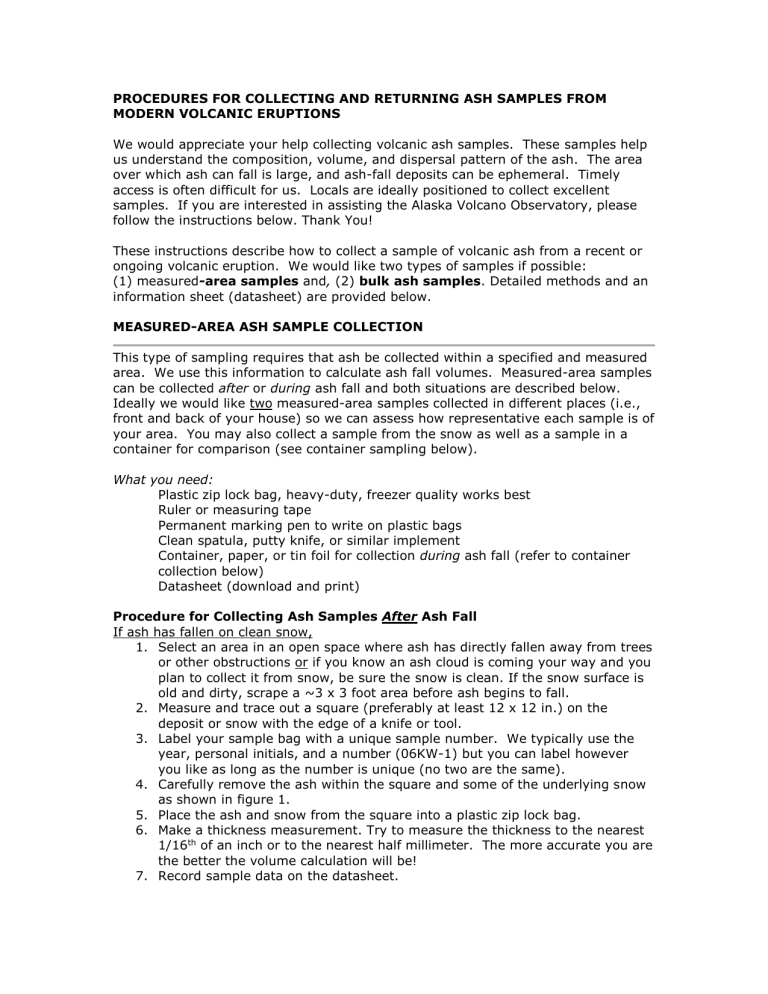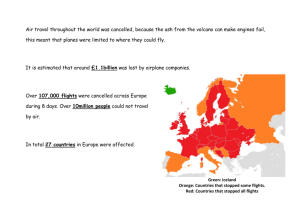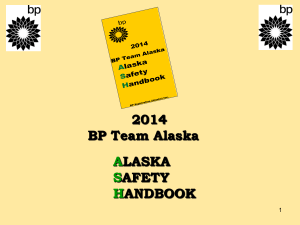- Alaska Volcano Observatory

PROCEDURES FOR COLLECTING AND RETURNING ASH SAMPLES FROM
MODERN VOLCANIC ERUPTIONS
We would appreciate your help collecting volcanic ash samples. These samples help us understand the composition, volume, and dispersal pattern of the ash. The area over which ash can fall is large, and ash-fall deposits can be ephemeral. Timely access is often difficult for us. Locals are ideally positioned to collect excellent samples. If you are interested in assisting the Alaska Volcano Observatory, please follow the instructions below. Thank You!
These instructions describe how to collect a sample of volcanic ash from a recent or ongoing volcanic eruption. We would like two types of samples if possible:
(1) measured-area samples and, (2) bulk ash samples. Detailed methods and an information sheet (datasheet) are provided below.
MEASURED-AREA ASH SAMPLE COLLECTION
This type of sampling requires that ash be collected within a specified and measured area. We use this information to calculate ash fall volumes. Measured-area samples can be collected after or during ash fall and both situations are described below.
Ideally we would like two measured-area samples collected in different places (i.e., front and back of your house) so we can assess how representative each sample is of your area. You may also collect a sample from the snow as well as a sample in a container for comparison (see container sampling below).
What you need:
Plastic zip lock bag, heavy-duty, freezer quality works best
Ruler or measuring tape
Permanent marking pen to write on plastic bags
Clean spatula, putty knife, or similar implement
Container, paper, or tin foil for collection during ash fall (refer to container collection below)
1.
Datasheet (download and print)
Procedure for Collecting Ash Samples After Ash Fall
If ash has fallen on clean snow,
Select an area in an open space where ash has directly fallen away from trees
2.
or other obstructions or if you know an ash cloud is coming your way and you plan to collect it from snow, be sure the snow is clean. If the snow surface is old and dirty, scrape a ~3 x 3 foot area before ash begins to fall.
Measure and trace out a square (preferably at least 12 x 12 in.) on the deposit or snow with the edge of a knife or tool.
3.
Label your sample bag with a unique sample number. We typically use the year, personal initials, and a number (06KW-1) but you can label however you like as long as the number is unique (no two are the same).
4.
Carefully remove the ash within the square and some of the underlying snow as shown in figure 1.
5.
Place the ash and snow from the square into a plastic zip lock bag.
6.
Make a thickness measurement. Try to measure the thickness to the nearest
1/16 th of an inch or to the nearest half millimeter. The more accurate you are the better the volume calculation will be!
7.
Record sample data on the datasheet.
8.
Bring the bag(s) into a warm place so that the snow will melt. Placing the bag in a pot will keep it from tipping over as the snow melts. Let the ash settle out and then pour off as much water as you can without losing any ash.
This may take a couple of tries, letting the ash resettle each time. Leave the bag open to allow the sample to dry a bit for a day or so (doesn’t need to be totally dry, just dry enough to ship). Reseal and double bag the sample and return to AVO at the address below.
9.
If you have a camera, we would appreciate photos of the ash sampling location. Please send them to us with your ash sample.
Figure 1. Collection of measured-area ash samples from snow pack after the 1992 eruption of Crater Peak/ Mount Spurr, AK (photo taken on 9/24/92).
If ash fall is unexpected - no snow, no container,
If ash falls unexpectedly at your location when there’s no snow and before you can get a suitable container placed:
1.
Select an area in an open space where ash has directly fallen onto a hard, flat, smooth surface (e.g., fairly flat roofs, steps not covered by an overhang, docks, machinery, etc.) away from trees or other obstructions.
2.
Make a thickness measurement. Try to measure the thickness to the nearest
1/16 th of an inch or to the nearest half millimeter. The more accurate you are the better the volume calculation will be!
3.
Measure and trace out a square (preferably at least 12 x 12 in.) on the
4.
deposit with the edge of a knife or tool.
Carefully remove or push away ash several inches from the outer perimeter of the marked square as shown in figure 2; this often makes it easier to cleanly collect the ash within the marked square.
Alaska Volcano Observatory
Ash Collection Instructions
2
5.
Label your sample bag with a unique sample number. We typically use the year, personal initials, and a number (06KW-1) but you can label however you like as long as the number is unique (no two are the same).
6.
Use a knife, spatula, or brush to carefully scrape the ash off (within the area of the measured square) into a container and then transfer to a plastic bag
(figure. 2).
7.
Record sample data on datasheet. Seal and double bag the sample and return to AVO at the address below.
8.
If you have a camera, we would appreciate photos of the ash sampling location. Send them to us with your ash sample.
Figure 2. Collection of measured-area tephra samples from hard surfaces after 1992 eruption of Crater Peak/Mount Spurr, AK (photo from 9/21/92).
Procedures for Collecting Ash Samples During Ash Fall
If ash is coming your way and you’ve got time to prepare, follow these instructions.
This is an opportunity to obtain more detailed information about the ash fall. This method will also help avoid contamination and prevent the ash from being blown away. The following instructions are for collection into a container or onto a piece of paper or tin foil that is placed at the start of ash fall (or prior to), and left out the entire duration of the event. If you have the time, we would love to have
samples collected incrementally through time during a single ash fall event!
If you are interested in this type of sampling refer to the section on time-incremental sampling below.
Collecting ash sample using a container,
1.
Select a container that can be easily measured (diameter for circular containers or length and width for square or rectangular containers). A thinlipped container works best and square or rectangular containers must not have large tapered or rounded lips.
2.
Make a couple of measurements from inside edge to inside edge of the
3.
container lip (figure 3).
Place the container in an open area away from trees or other obstructions.
Alaska Volcano Observatory
Ash Collection Instructions
3
4.
Record time and date that ash fall begins and ends. Time should be recorded as accurately and precisely as possible.
5.
After the ash falls, try to make a thickness measurement in the container or on nearby flat surfaces. Try to measure the thickness to the nearest 1/16 th of an inch or to the nearest half millimeter. The more accurate you are the better the volume calculation will be!
6.
Remove any ash from the lip of the container using a brush or your fingers trying not to get any into the container (we only want ash that falls into the container not on the lip of the container).
7.
Label your sample bag with a unique sample number. We typically use the year, personal initials, and a number (06KW-1) but you can label however you like as long as the number is unique (no two are the same).
8.
Empty ash from container into a plastic zip lock bag.
9.
Record sample data on datasheet. Seal and double bag the sample and return to AVO at the address below.
Figure 3. For rectangular and square containers, measure length (l) and width (w) of the inside lip of the container, and the diameter (d) of the inside lip for circular containers. Don’t worry about the depth or shape of the container beneath the lip; it doesn’t matter for this area measurement.
Collecting ash sample using paper or tin foil,
1.
A piece of standard copy paper or trimmed tin foil can be used as a collection surface; there is no need to measure the paper or foil, it will be included with the sample and we can measure it later.
2.
Place the paper or foil on a flat surface in open area away from trees or other obstructions.
3.
Record time and date that ash fall begins and ends. Time should be recorded as accurately and precisely as possible.
4.
Make a thickness measurement of ash on a nearby flat surface. Try to measure the thickness to the nearest 1/16 be! th of an inch or to the nearest half millimeter. The more accurate you are the better the volume calculation will
Alaska Volcano Observatory
Ash Collection Instructions
4
5.
Label your sample bag with a unique sample number. We typically use the year, personal initials, and a number (06KW-1) but you can label however you like as long as the number is unique (no two are the same).
6.
After ash fall ends, carefully lift the edges of the paper to shift the ash towards the center. Then pick the paper up and pour the ash into your plastic sample bag.
7.
Fold the paper up and include it in the bag; we need this to measure the area of the sample.
8.
Record sample data on datasheet. Seal and double bag the sample and return to AVO at the address below.
Collecting time-incremental ash samples,
These instructions are for collecting ash samples at set time intervals during an ash fall event. It will take some dedicated time and focus. This type of sampling helps us to see when various size particles fall out of the plume, how chemistry varies through time etc. and is incredibly valuable data that is almost never collected! So if you are up to sampling at a regular time interval and live within the fall out zone of ash fall, we would love these data. Thank You!
What you need:
Watch, with accurate time, Alaska Standard Time (AST); time on your cellular phone is a good reference.
Container, standard sheet of paper, or foil
Plastic zip lock bag, heavy-duty, freezer quality works best
Permanent marking pen to write on plastic bag
Datasheet (download and print)
Procedures for Collecting Time-Incremental Ash Samples
1.
Before ash begins falling, place a container, paper, or foil out in an open space away from trees or other obstructions. There is no need to measure
2.
the container; we only need a bulk sample.
Decide on a regular schedule for replacing container/paper/foil during ash fall event (every 30 minutes is optimum for most eruptions)
3.
Have extra containers/paper/foil ready to deploy at your set interval (i.e., to
4.
replace existing container)
Label your sample bags with unique and sequential sample numbers (make a few up ahead of time)
5.
Record time and date that ash fall begins and ends for each collection interval
(i.e., sample 06KW-1, 8:30 am- 9:00 am 3/21/06). Time should be recorded
6.
as accurately and precisely as possible.
Record sample data on datasheet. Place all bags of individual samples together in a large plastic zip lock bag so we know they are all from the same ash fall event. Seal and double bag the samples and return to AVO at the address below.
Alaska Volcano Observatory
Ash Collection Instructions
5
BULK ASH SAMPLE COLLECTION
In addition to the measured-area sample(s), we would like to have a bulk ash sample for use in determining the chemistry and glass content of the ash, as well as for other analyses. Knowing or measuring the area is not important. The goal is to collect as much sample as reasonably possible (up to a quart bag but as small as a teaspoon is useful).
What you need:
Plastic zip lock bag, heavy-duty, freezer quality works best
Permanent marking pen to write on plastic bag
1.
Clean spatula, putty knife, or anything to scoop up the ash
Collection with preparation time prior to ash fall event,
Select a large collection area since many ash-falls are relatively light (thin), the larger the collection area the better.
2.
Label your sample bag with a unique sample number. We typically use the
3.
year, personal initials, and a number (06KW-1) but you can label however you like as long as the number is unique (no two are the same).
Place a plastic tarp or other similar plastic sheet out in an open area to collect ash.
4.
Record time and date that ash fall begins and ends. Time should be recorded as accurately and precisely as possible.
Empty ash from plastic tarp into a container and then into a sample bag. 5.
6.
Record sample data on datasheet. Seal and double bag the sample and return to AVO at the address below.
Collection after ash fall event,
1.
Label your sample bag with a unique sample number. We typically use the year, personal initials, and a number (06KW-1) but you can label however
2.
you like as long as the number is unique (no two are the same).
Select a smooth, flat surface that is covered with ash and scrape or brush this ash into your sample bag.
3.
Record time and date that ash fall began and ended, if known. Time should be recorded as accurately and precisely as possible.
4.
Record sample data on datasheet. Seal and double bag the sample and return to AVO at the address below.
Alaska Volcano Observatory
Ash Collection Instructions
6
SUMMARY OF INFORMATION TO BE INCLUDED WITH EACH SAMPLE
A.
Sample Number
For example: year, personal initials, and a number (06KW-1) but you can label however you want as long as the number is unique (no two are the same).
B.
Date & Time of Collection
If you collected ash during an ash fall event please indicate the time ash began falling and when it stopped (i.e., duration of ash collection). We need accurate times to the nearest minute (i.e., the time on your cellular phone is usually accurate Alaska Standard Time)
C.
Location of Collection
GPS location, map location, street address, general location, whatever you can provide (more detail is better).
D.
Dimensions of Container
Give length, width, or diameter of inside edge of container lip. Please specify units (inches, centimeters) e.g., L=12 cm, W= 10 cm, or D = 6 cm.
E.
Thickness of Ash Layer (to the nearest 1/16 inch or ½ millimeter )
If you don’t have a metric ruler use an inch ruler rather than guessing, it’s amazing how easy this is to overestimate. There is a metric ruler on the datasheet that you can cut out and use. The more accurate you are the better the volume calculation will be!
F.
Describe surface upon which ash has fallen
Snow, ice, metal roof, wood, etc.
G.
Describe weather conditions during ash fall, if known
Wind speed, wind direction, gusty or not, snowfall or rainfall during ash deposition, etc.
H.
Photos
If you have photos of your sampling routine or of people doing the sampling please send them to the address above or if digital, send to kwallace@usgs.gov.
Please only send copies or digital images as they will not be returned. All photos will be credited to photographer.
Please send samples and sample information to:
USGS/Alaska Volcano Observatory, c/o Tephra Lab
4230 University Dr., Suite 201
Anchorage, AK 99508
For more information contact us, 907-786-7497, kwallace@usgs.gov
Alaska Volcano Observatory
Ash Collection Instructions
7
Volcano information can be found on our website: http://www.avo.alaska.edu
These instructions can be found on the AVO website: http://www.avo.alaska.edu/ashfall.php
Thank you for your contribution to volcano science in Alaska!
OMB Control Number: 1028-0106
Expiration Date: May 31, 2016
PAPERWORK REDUCTION ACT STATEMENT: A Federal agency may not conduct or sponsor, and a person is not required to respond to a collection of information unless it displays a currently valid OMB control number. Public burden for reviewing these instructions is estimated to average 3 minutes per response. Comments regarding this collection of information should be directed to the Bureau Clearance
Officer, U.S. Geological Survey, 12201 Sunrise Valley Drive, MS 807, Reston, VA 20192, or call 703-648-
7174.
Alaska Volcano Observatory
Ash Collection Instructions
8
DATA COLLECTION SHEET (please print, fill out, and submit with your samples)
A
Sample
Number
B
Date & time of
Collection (or duration if applicable)
C
Location of collection
D
Dimensions of container
E
Thickness of ash layer
(nearest ½ millimeter)
F
Describe surface upon which ash has fallen
G
Describe weather conditions during ash fall, if known
Please send samples and sample datasheet to:
USGS/Alaska Volcano Observatory, 4230 University Drive, Suite 201, Anchorage, AK 99508, 907-786-7497
Collector Contact Information: Name
_______________________
, Phone
________________
_____________________
H. Photos
Please indicate if you give permission to the Alaska Volcano Observatory to use your photographs on their
Webpage
__________________________
all photos
____
select photos only
____
(please indicate which images). signature
Please only send copies or digital images as they will not be returned. All photos will be credited to photographer.
Alaska Volcano Observatory
Ash Collection Instructions
9








